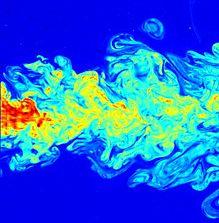
Contents
Many flows in nature and in industrial situations are turbulent. This course serves as an introduction in the theory of such turbulent flow phenomena. Since turbulent flows emerge as a result of instability processes of laminar flows, the course starts with stability analysis. Subsequently, the following subjects are considered: general features of turbulence including statistical properties and spectra, the structure of turbulent flows near walls, some aspects of vorticity and the energy budget, closure models, introduction to numerical techniques such as k- modelling and LES, and turbulent diffusion
Learning objectives
The student obtains basic knowledge about the theory of turbulent flow phenomena. Specific goals are:
- to analyse stability/instability of laminar flows;
- to gain understanding of the basic phenomenological theory of turbulence;
- to analyse the statistical properties of turbulence using statistical procedures;
- to characterize turbulent flows using the concepts of correlation functions and spectra;
- to analyse the structure of turbulent flows near walls;
- to analyse the production, transport and dissipation of energy in turbulent flows;
- to apply the concept of vorticity to turbulent flows;
- to be familiar with numerical techniques related to turbulence modelling.
-
dh.ir. Trieling, R.R.